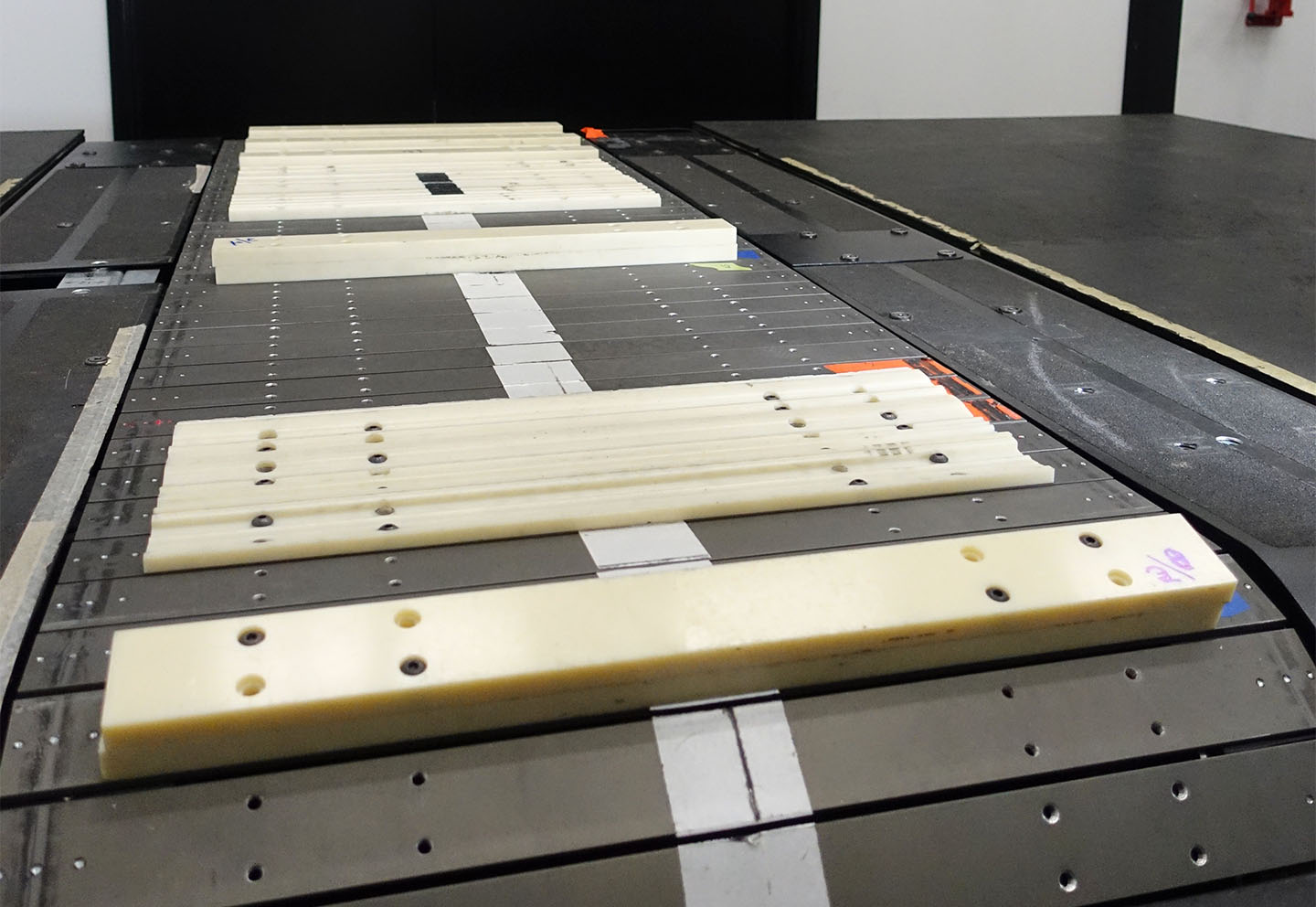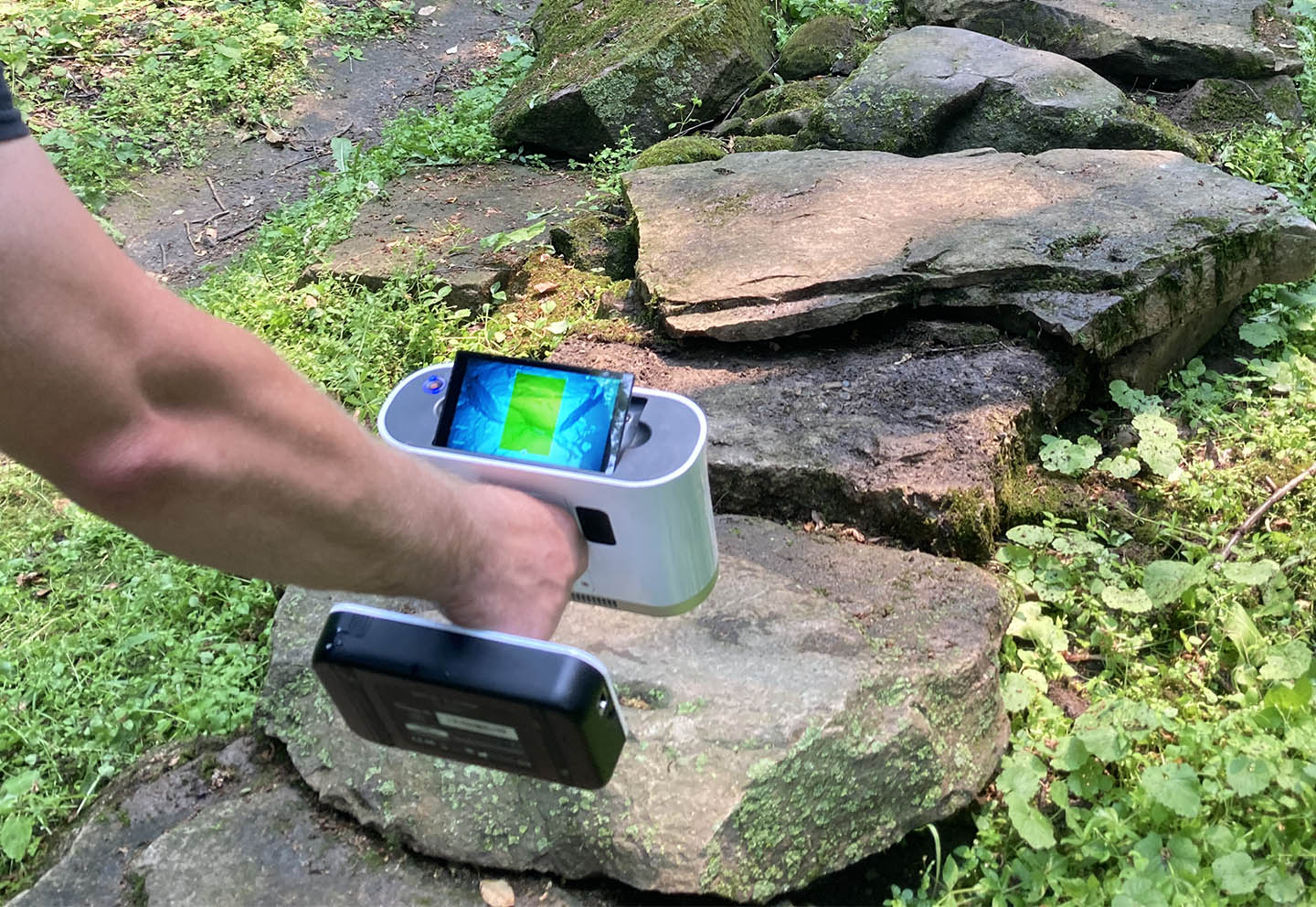- Innovation
- 11 October, 2023
The groundbreaking science behind Supercaliber Cutting-edge testing reveals how Supercaliber Gen 2 is Trek’s fastest and most capable cross-country mountain bike ever
With revamped Isostrut suspension, Supercaliber Gen 2 takes cross-country efficiency, control, and comfort to new levels, so riders can soar up climbs, crush technical descents, and hammer to the podium with plenty of power left in the tank. Geek out with Trek Performance Research Engineers as they explore these performance gains in an unprecedented set of industry-first lab and trail tests.
The new IsoStrut
For Supercaliber Gen 2, Trek MTB engineers took their unique IsoStrut design to the next level, giving riders significant improvements in efficiency, control and comfort.

At a glance, it’s easy to spot that Supercaliber’s 33% increase in travel allows for greater overall axle movement. This includes both compression and extension from the sag position, allowing for more room to compress upward on impacts and more room to extend downwards into blown-out ruts and the backside of bumps. Further, Supercaliber Gen 2 also delivers an 18% higher leverage ratio, making the shock more responsive as it overcomes seal friction with greater ease. Finally, Trek and RockShox engineers worked closely to tune the compression damping for a race-ready balance of pedaling efficiency and terrain response, while the increased travel delivers faster rebound tuning to keep the wheel glued to the trail.
For the rider, this all adds up to less effort to go fast (more efficiency), better traction (more control), and a smoother ride (more comfort). To illustrate these performance benefits, Trek Performance Research engineers conducted an unprecedented set of tests both in the lab and on the trail.
Efficient through the rough
Any cross-country racer knows that pedaling efficiency over roots and rocks is paramount. Suspension plays a critical role in preserving forward momentum, keeping the tire planted on the ground, and reducing uncomfortable and disruptive chassis motion. In short, a great suspension will simultaneously improve efficiency, control, and comfort.
Lab meets trail
Supercaliber’s efficiency while pedaling through rough terrain was tested on the Trek Performance Research Lab treadmill, where we can avoid line choice and handling variability, while precisely controlling temperature, speed, and terrain profile. To create the terrain profile, we first rode the Trek Trails with a shock sensor to measure suspension activity over a rooty section of trail. Using this data, we tuned the treadmill profile to match the trail’s suspension activity.



Efficiency
Measured by metabolic mask
After correlating our treadmill surface to the trail, we used a VO2 Master metabolic mask to measure overall rider and bike system efficiency for Supercaliber Gen 2, Supercaliber Gen 1, and a hardtail. This mask measures the rider’s oxygen consumption, which is a metric for the total energy that the rider exerts.
Why not rely on a power meter alone for efficiency comparisons? Power meters only account for energy utilized to propel the bike, neglecting the rider’s effort to absorb repeated impacts and control the bike over rough terrain. Measuring oxygen consumption is therefore the definitive way to determine which bike is the fastest.

To achieve a consistent and valid oxygen consumption metric, we conducted 5-minute, 16 km/h (10 mph) trials at 60% of the rider’s functional threshold power – which equates to a significant but sustainable effort. By digging into the data with a fine-toothed comb, we ensured the stability of our primary metric (oxygen consumed) and secondary variables (like heart rate and crank power), allowing us to verify that fatigue was not setting in. For additional consistency, the shocks were set up to the same 29% sag and adjusted to factory-recommended settings from the Trek Suspension Calculator.
Enough about protocols — show the result already
From our testing under these conditions, Supercaliber Gen 2 measured 6% more efficient than Supercaliber Gen 1 and 23% more efficient than a hardtail for the same pedaling task.

“under these conditions, Supercaliber Gen 2 was 6% more efficient than Supercaliber Gen 1”
Comfort
Measured with 3D motion capture
Supercaliber Gen 2 measured in as the most efficient bike largely because its updated IsoStrut suspension provides the smoothest ride. On rough terrain, that means absorbing bumps (shock spring) and dissipating that energy (shock damping) so minimal motion is transferred to the bike touchpoints (handlebars, pedals, and saddle). This bump absorption reduces the rider’s tendency to use energy from their muscles to absorb the impacts and maintain control. Of course, the smoothest bike is also the most comfortable to ride.

To explore these effects, an array of twelve 3D cameras precisely tracked the motion of markers placed all over the bike and body, capturing data at a rate of 360 times per second. Each bike was recorded for 60 laps of the treadmill, and inconsistencies between laps were minimized by averaging the data down into a single average lap.

We first focused in on the bottom bracket area, where the legs have the first shot at absorbing vertical motion and preserving an efficient pedal stroke. As we see in the upper plot, Supercaliber Gen 2 significantly reduced the vertical motion of the chassis at the bottom bracket by 15%, meaning the rider takes less of a beating through their feet and can put more energy into pedaling rather than stabilizing their body.
Second, we looked at the relative motion between the saddle and the rider’s pelvis (sacrum). This metric should ideally be zero, apart from the pedal stroke’s cyclical effect. More variability in this saddle-to-pelvis distance suggests the bike is propelling the rider up from the saddle or the rider is using their legs to hover and let the saddle move around. Either condition leads to less efficient pedaling. As we see in the lower plot, Supercal Gen2 had 22% less relative saddle-to-pelvis motion than its predecessor.
Control
Measured with a high-speed camera
You can only ride as fast as you can control the bike. A primary role of suspension is to keep the tire glued to the undulating ground, thus improving traction & control. Plus, more traction also means more efficient power transfer for propelling the bike forward.
In this video, we see a comparison between the axle motion of the Supercaliber Gen 2 (blue) and Supercaliber Gen 1 (orange). When the axle markers are overlaid, we see that Gen 2 maintained faster, more composed control over the rear wheel and regained traction more quickly after impacts.
Suspension activity
Measured with a shock sensor


Pedaling over a rough treadmill surface.
Controlled descending through harsher terrain
So far, our testing investigated performance while pedaling through rough terrain – certainly a key factor in cross-country racing. But modern cross-country courses increasingly reward bikes with the prowess to confidently charge through technical features and rocky descents, too. To investigate how Supercaliber Gen 2 would perform in this type of terrain, we ditched the lab coats, grabbed our portable pocket protectors, and headed back to the woods.
Heading back to the trail
Back on the Trek HQ mountain bike trails, we identified a rocky descent and started by precisely mapping its topology using a high-resolution 3D laser scanner. This stretch of rocks measured about 8m (25ft) long, on a 15% downslope, and included multiple bumps and drops up to 180mm (7in) tall.


Comfort & efficiency
Measured with 3D motion capture
With the help of huge tripods, custom tree mounts, and hundreds of feet of cable, we recreated our lab’s array of twelve 3D motion capture cameras out in the woods. This groundbreaking test technique allowed us to precisely reconstruct the bike’s motion and position on the trail.
Since the trail is a less controlled environment than the lab, we made every effort to control factors such as entry speed and line choice. Thanks to 3D tracking of the bike over multiple runs, we made valid comparisons by measuring these factors and grouping similar runs together. In the end, we analyzed 5 runs on each bike with an average entry speed of 21 km/h +/- 0.7 (std) (13mph+/-0.5 (std)). With the help of markers on both the bike and the trail itself, we calculated each bike’s lateral entry position into the trail to be consistent within 0.10m (3.9 in).


By tracking the bike’s moving parts individually, we looked for differences in the Supercaliber Gen 2 in all dimensions – lateral bucking, suspension usage, forward progression, ride smoothness, ground tracking — you name it. In the following video, we illustrate how the rear axle was tracked relative to the laser-scanned trail surface and then show the axle paths from all runs overlaid for comparison.
Rear axle and chassis tracking gave us the bike’s precise position and speed in space. Subtle variability in run lines and fewer repetitions compared to the treadmill made it difficult to repeat the same analysis we used on the treadmill, but other approaches to the data supported the same trends. Again, it was apparent how Supercaliber Gen 2 did a superb job smoothing the ride, leaving more energy for the rider to hammer on the pedals later down the line.
Supercaliber Gen 2 also maintained more momentum over obstacles, as was easily observed on an isolated rock towards the end of the run. If we look at the bikes traveling over this rock, Gen 2’s superior suspension helped soften the impact without losing speed. We saw minimal variation in speed over the same distance and less speed lost overall from entry to exit when compared to Supercaliber Gen 1 and the hardtail.

Control
Measured with a high-speed camera
Using a high-speed camera, we can precisely track axle motion and measure traction as the tire disconnects and reconnects with the trail. A slider rail system, combined with a nimble engineer and plenty of outtakes, gave us a close-up, moving view of IsoStrut in action, while a static tripod low to the ground provided calibrated 2D motion tracking.

As we saw in the video, the Supercaliber Gen 2’s wheel tracked the terrain more closely and regained traction faster after large drops and impacts. In the case of the two largest drops in the video frame, Supercaliber Gen 2 regained traction 14-50% sooner than the other test bikes. Better connection to the trail means more control for braking and steering.
Suspension activity
Measured with a shock sensor


Coasting over a harsh trail descent.
In Summary
We hope you enjoyed this glimpse into the Trek Performance Research and the cutting-edge testing developed to illustrate Supercaliber Gen 2’s next-level efficiency, control, and comfort. Believe it or not, this article just scratches the surface of our ongoing testing to help make your ride faster, more comfortable, and more fun. We’ll keep you updated in future articles as we continue to prove out new theories in bike science, and in the meantime go check out Supercaliber Gen 2!

About the authors
Paul Harder is a Principal R&D Engineer at Trek Bicycle. Since earning an MS in Mechanical Engineering from the University of Wisconsin in 2007, he has dedicated his career to making your ride better through science and innovation.
Wendy Ochs, PhD is a Biomechanics Research Engineer at Trek Bicycle. She holds a doctorate in Biomedical Engineering from the University of Wisconsin, Madison.
Kyle Russ, Lead Biomechanical Engineer, has been studying the rider-bicycle interaction for Trek Bicycle since 2011. His passion for understanding human movement and physiology of cyclists started while pursuing his master’s from Ohio State University.








